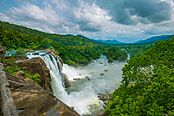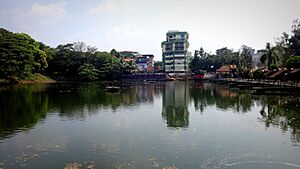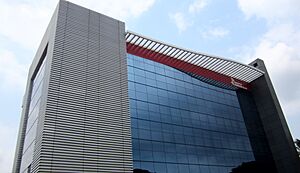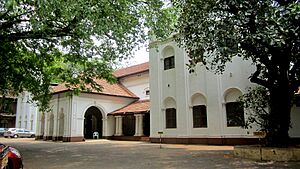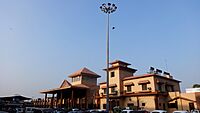Thrissur facts for kids
Quick facts for kids
Thrissur
Trichur, Thrissivaperur
|
|
|---|---|
|
Clockwise from top:
Thrissur city, Metharapolitha Cathedral, Cape of Kodungallur, Athiralpalli waterfalls, Clock tower, Sakthan Thampuran Palace, Vadakkunnathan Temple |
|
| Country | |
| State | Kerala |
| District | Thrissur |
| Government | |
| • Type | Mayor–council government |
| • Body | Thrissur Municipal Corporation |
| Area | |
| • Metropolis | 101.42 km2 (39.16 sq mi) |
| Area rank | 4th |
| Elevation | 39.58 m (129.86 ft) |
| Population
(2011)
|
|
| • Metropolis | 1,367,742 |
| • Rank | 113th |
| • Density | 7,048/km2 (18,250/sq mi) |
| • Metro | 2,406,791 |
| Demonym(s) | Thrissurkaran (male) Thrissurkari (female) Thrissurkar (plural) |
| Languages | |
| • Official | Malayalam, English |
| Time zone | UTC+5:30 (IST) |
| PIN |
680xxx
|
| Telephone codes | Thrissur: +91487xxxxxxx, Irinjalakuda: +91480xxxxxxx, Wadakkancherry: +914884xxxxxx, Kunnamkulam: +914885xxxxxx |
| Vehicle registration | KL-08 |
| Coastline | 54 kilometres (34 mi) |
| Literacy rate | 97.24% |
| Importance | cultural capital of Kerala |
| Climate | Am/Aw (Köppen) |
| Precipitation | 3,100 millimetres (120 in) |
| Avg. summer temperature | 35 °C (95 °F) |
| Avg. winter temperature | 20 °C (68 °F) |
| Website | https://thrissur.nic.in/ |
Thrissur (Malayalam: [t̪riʃ(ː)uːr]), once called Trichur, is a big city in Kerala, India. It is the main city of the Thrissur district. Thrissur is the third largest group of cities in Kerala, after Kochi and Kozhikode. It is built around a hill called Thekkinkadu Maidanam, which is home to the famous Vadakkunnathan Temple. The city is about 304 kilometers (189 miles) northwest of Thiruvananthapuram, the capital of Kerala.
Thrissur was once the capital of the Kingdom of Cochin. It was a meeting point for many different groups of people from history. These included the Assyrians, Greeks, Persians, Arabs, Romans, Portuguese, Dutch, and English.
Thrissur is known as the cultural capital of Kerala. This is because it has a rich history of culture, spirituality, and religion. The city has important places like the Kerala Sangeetha Nadaka Academy for music and drama. It also has the Kerala Lalithakala Akademi for fine arts and the Kerala Sahitya Academy for literature.
The city hosts the Thrissur Pooram festival. This is the most colorful and amazing temple festival in Kerala. It happens at the Thekkinkadu Maidan of Vadakumnathan Temple in April or May.
Religion is very important in Thrissur. The city has been a center for Hindu learning for a long time. It is also believed that Christianity, Islam, and Judaism first came to India through Thrissur. The city has many famous temples, including the Vadakkumnathan temple, Thiruvambadi Sri Krishna Temple, and Paramekkavu temple. There are also three big Catholic churches. These include the St. Antony's Syro-Malabar Catholic Forane, Our Lady of Lourdes Syro-Malabar Catholic Metropolitan Cathedral, and Our Lady of Dolours Syro-Malabar Catholic Basilica. The Basilica is the largest Christian church in India. Thrissur is also home to the Academy of Sharia and Advanced Studies. This is an Islamic school that also teaches Sanskrit and Hindu texts.
Thrissur is a major center for banks and businesses. It is the main office for four big banks in India. These are South Indian Bank Ltd, Catholic Syrian Bank, Dhanalakshmi Bank, and ESAF Small Finance Bank. The city is also famous for its silks and gold jewelry. Many tourists visit Thrissur, making it a top spot for visitors in Kerala.
The city is also a big place for education. It has many schools and colleges. Some of these include the Kerala Kalamandalam for arts, Kerala Agricultural University, and Kerala University of Health Sciences. There are also colleges for veterinary science, engineering, and medicine.
Contents
What's in a Name?
The name Thrissur (Malayalam: തൃശൂര്) is a shorter version of the old Malayalam word Thirusshivaperoor. This means "Place of Lord Shiva's Name." The city gets its name from the Vadakkumnathan Temple, which is dedicated to the god Shiva. Until 1990, the city was known by its English name, Trichur. Then, the government changed it back to its Malayalam name, Thrissur. In ancient times, Thrissur was also called "Vrishabhadripuram." This name meant "Kailasam of the South," referring to Shiva's home.
Thrissur's Past
Old stone monuments and tombs show that people have lived in Thrissur for a very long time. They were here from at least 1000 BCE to 500 CE.
In the 16th century, the Portuguese had control over the seas in many parts of Kerala, including Thrissur. By the early 17th century, the Dutch took over as the main naval power. With the help of the Dutch, the royal family of the Kingdom of Cochin won back Thrissur in 1710.
Thrissur became very important after Maharaja Sakthan Thampuran became king of Cochin (1769–1805). He made Thrissur his capital city. The Maharaja helped the city become a major center for money and trade in South India. He invited Syrian Christian families and Brahmins to move there.
Between 1750 and 1760, Hyder Ali, the ruler of the powerful Kingdom of Mysore, took over Thrissur. This made Thrissur a state that had to pay taxes to Mysore. In 1786, Tipu Sultan's son led another attack on Thrissur. But he left after the Srirangapattanam war. Later, Rama Varma X, the king after Sakthan Thampuran, made a deal with the East India Company. This made Cochin a British-controlled state.

The movement for India's independence grew stronger after 1919. Many people in Thrissur joined the civil disobedience movement. Mahatma Gandhi visited the city in 1927 and 1934 to support it.
R. K. Shanmukham Chetty, who was a top official in Cochin from 1935 to 1941, helped develop the city. He built the Thrissur Town Hall and Ramanilayam. These buildings are still important in Kerala politics today. Other important buildings and roads built around this time include the Municipal Corporation Building and the Swaraj Round.
In 1947, when India became independent, Thrissur was part of the Kingdom of Cochin. The Thrissur district was created on July 1, 1949. The city of Thrissur became its main office.
City Layout
Thrissur is the main city of Thrissur district in the center of Kerala, India. It is about 75 kilometers (47 miles) northeast of Kochi. The city is built on a hill called Thekkinkadu Maidan. This hill is the second highest point in the city. The city is about 2.83 meters (9.3 feet) above sea level.
From the hill, the city gently slopes down into the Thrissur-Ponnani Kole Wetlands. These wetlands act like a natural drain for the city. Water from the wetlands flows into the Laccadive Sea through rivers. This helps protect Thrissur from major floods that affect other cities in Kerala.
The city is in the middle part of Kerala. Its land is mostly made of old rocks called Archaean gneisses and crystalline schists. Thrissur is near the center of the Indian tectonic plate. This means it has very little seismic (earthquake) or volcanic activity.
Weather in Thrissur
Thrissur has a tropical monsoon climate. This means it has hot, wet summers and warm, dry winters. Summer is from March to May and is the hottest time. Temperatures can reach 36 to 38°C (97 to 100°F) with high humidity.
After summer comes the south-west monsoon from June to September. October and November are the post-monsoon months. Winter is from December to February. It is cooler and windier, with winds coming from the Western Ghats. Winter months are usually dry and less humid. Morning temperatures are cool, and daytime temperatures are around 30°C (86°F).
The city gets a lot of rain during the monsoon season. The average yearly rainfall is about 3100 millimeters (122 inches). The southwest monsoon usually starts in late May. Rainfall decreases after July. On average, there are 124 rainy days in a year.
| Climate data for Thrissur | |||||||||||||
|---|---|---|---|---|---|---|---|---|---|---|---|---|---|
| Month | Jan | Feb | Mar | Apr | May | Jun | Jul | Aug | Sep | Oct | Nov | Dec | Year |
| Mean daily maximum °C (°F) | 31 (88) |
32 (90) |
35 (95) |
36 (97) |
35 (95) |
30 (86) |
29 (84) |
30 (86) |
30 (86) |
30 (86) |
31 (88) |
31 (88) |
32 (89) |
| Mean daily minimum °C (°F) | 21 (70) |
22 (72) |
25 (77) |
27 (81) |
27 (81) |
24 (75) |
23 (73) |
23 (73) |
24 (75) |
24 (75) |
23 (73) |
22 (72) |
24 (75) |
| Average rainfall mm (inches) | 32 (1.3) |
26 (1.0) |
39 (1.5) |
147 (5.8) |
391 (15.4) |
576 (22.7) |
391 (15.4) |
367 (14.4) |
417 (16.4) |
467 (18.4) |
223 (8.8) |
47 (1.9) |
3,123 (123) |
| Average rainy days (≥ 0.1 mm) | 3 | 3 | 5 | 13 | 17 | 26 | 28 | 24 | 18 | 23 | 13 | 4 | 177 |
| Source: [1] | |||||||||||||
Thrissur's Economy
Thrissur is a major center for business and money in Kerala. King Sakthan Thampuran invited business families to settle here long ago. This helped Thrissur become a busy trading hub.
The city is a big place for making gold and rolled gold jewelry in South India. About 70% of Kerala's jewelry is made in Thrissur. There are around 3,000 jewelry workshops in the city. These workshops employ about 40,000 people. They craft almost 85% of the one tonne of gold used daily in Kerala.
Thrissur has been known as a banking city since the 1930s. Today, it is still an important center for banking and finance. Many major banks have their main offices here. These include South Indian Bank, Catholic Syrian Bank, and Dhanalakshmi Bank. Many chit funds, which are a type of savings and credit system, are also in Thrissur. In 2010, about 3,000 chit fund companies were in Thrissur, employing around 35,000 people.
The city is also a hub for making Ayurvedic medicines. About 150 of Kerala's 850 Ayurvedic medicine companies are located in or near Thrissur. Some of the largest ones, like Oushadhi, are here.
Big retail businesses like Kalyan Group and Joyalukkas have stores in Thrissur. InfoPark Thrissur, a technology park, is also in the district. Tourism also brings a lot of money to Thrissur. Many local tourists use the city as a base to explore Kerala's popular tourism spots. Thrissur is ranked first for the number of local tourists visiting Kerala. This is due to its temples, old churches, and rich culture.
How Thrissur is Governed
| City Leaders | ||
|---|---|---|
| Mayor | M K Varghese | |
| Police Commissioner | R Adithya IPS | |
| Deputy mayor | Rajashree Gopan | |
| State Assembly Members | ||
| Thrissur Assembly Constituency | P. Balachandran | |
| Ollur Assembly Constituency | K. Rajan (politician) | |
| Member of Parliament | ||
| Thrissur Lok Sabha constituency | Suresh Gopi | |
Thrissur has been a municipality since 1921. In 1932, a new building for the city government was built. In 1972, more villages were added to the municipality. On October 1, 2000, Thrissur became a municipal corporation. This means it became a larger city government. It now includes towns and villages like Ayyanthole and Ollur.
The city is run by the Thrissur Municipal Corporation. It is led by a mayor. The corporation is divided into 52 areas called wards. People from these wards are elected to the city council for five years.
Thrissur is the second-largest city corporation in Kerala. The corporation manages power, water supply, and waste in the city. The Thrissur Urban Development Authority helps plan the city's growth.
Police Services
Thrissur is the main office for the Thrissur City Police and Thrissur Rural Police. The City Police is led by a Police Commissioner. The city is divided into four police areas: Thrissur, Kunnamkulam, Ollur, and Guruvayur. There are 24 police stations, including one for women and one for traffic.
The Thrissur City Police Commissionerate is located at Ramavarmapuram. The Thrissur Rural Police is at the District Collectorate complex in Ayyanthole. Thrissur is also the main office for the Inspector General of Police, Thrissur Range. This office handles law and order for Thrissur, Palakkad, and Malappuram districts.
The city also has the Kerala Police Academy. It has the Central Prison, Viyyur, a Police Dog Training Centre, and an Excise Academy and Research Centre. The Indian Reserve Battalion, a new commando unit, is also based in Ramavarmapuram. The Border Security Force has its first center in Kerala here.
People of Thrissur
| Historical population | ||
|---|---|---|
| Year | Pop. | ±% |
| 1941 | 57,500 | — |
| 1951 | 69,500 | +20.9% |
| 1961 | 73,000 | +5.0% |
| 1971 | 76,200 | +4.4% |
| 1981 | 77,900 | +2.2% |
| 1991 | 74,600 | −4.2% |
| 2001 | 317,526 | +325.6% |
| 2011 | 315,957 | −0.5% |
In 2011, Thrissur city had a population of 315,957 people. About 48.2% were males and 51.8% were females. The city has about 3,130 people per square kilometer. For every 1,000 males, there were 1,092 females. There are 66,827 households in the city. The average family size is 4.27 members.
The city has a very high literacy rate of 95.96%. This means most people can read and write. For males, the literacy rate is 97.37%, and for females, it is 94.72%.
Most people in Thrissur city are Hindus, making up 54.20% of the population. Christians are 40.04%, and Muslims are 5.50%. In the wider Thrissur district, Hindus are 58.42%, Muslims are 17.07%, and Christians are 24.27%.
Thrissur's Culture
Thrissur is known as the Cultural Capital of Kerala. It has a strong cultural history that goes back centuries.
Festivals and Celebrations
The Thrissur Pooram is the biggest festival in Kerala. It is sometimes called 'the pooram of all poorams'. It happens every year in April or May. For 36 hours, the city is filled with many people and elephants.
Puli Kali, also called Kavakali, is another festival. Thousands of people come to see it. Trained artists perform it during Onam, a harvest festival in Kerala. Buon Natale is a cultural festival held at Swaraj Round during Christmas. The Buon Natale parade set a Guinness World Records in 2014 for having the most people dressed as Santa Claus. Other important festivals in the city include Christmas, Onam, Diwali, Easter, Eid, and Vishu.
Elephants are a big part of many city festivals. Aanayoottu (feeding of elephants) is held at Vadakkunnathan Temple every year. It is the world's largest elephant feeding ceremony. It happens on the first day of the Malayalam month of Karkidakam.
Books and Writers
Thrissur has a long history of literature. It became very important after the Kerala Government set up academies for literature, music, and arts. After India became independent, Thrissur became known as the literary capital of Kerala. Many famous writers, poets, and speakers lived here.
Thrissur is home to important Malayalam writers. These include Kovilan, Kunhunni Mash, Sukumar Azhikode, and Sarah Joseph.
Places of Worship
The Vadakkunnathan temple is a great example of Kerala's unique architecture. It has many holy shrines and beautiful paintings. These paintings show stories from the Mahabharata.
The Thiruvambadi Sri Krishna Temple and Paramekkavu Bagavathi Temple are also in the city. They are among the largest temples dedicated to Sree Krishna and Bagavathi in Kerala.
Asia's tallest church is the Our Lady of Dolours Syro-Malabar Catholic Basilica (Puthan Pally). The Our Lady of Lourdes Syro-Malabar Catholic Metropolitan Cathedral has an underground shrine. The Saint Antony's Syro-Malabar Church, Ollur is called Chinna Roma (Small Rome). These churches are amazing examples of architecture and art. Saint Euphrasia's tomb and museum are also in the city. St. Thomas Syro-Malabar Church, Palayur is the first church in India. It is believed that Thomas the Apostle performed the first baptism here.
The Chettiyangadi Hanafi Mosque in Thrissur City is one of the oldest mosques in Thrissur. The Cheraman Juma Mosque in Kodungallur is said to be the first mosque in India.
Local Food
Thrissur's food is connected to its history and culture. Rice is the main food. Snacks like Achappam, Kuzhalappam, Vatteppam, Unniyappam, and Pazham Pori are common. Vellayappam, a type of rice pancake, is a special dish in the city. There is even a food street called vellayappam angadi.
Learning in Thrissur
Thrissur has been a center for learning for a long time. Now, it is growing as a modern education hub. Schools in the city are run by the Kerala Government or by private groups. Education is usually in English or Malayalam. Most schools follow the Kerala State Education Board, Indian Certificate of Secondary Education (ICSE), or Central Board for Secondary Education (CBSE). There are many primary schools, high schools, and higher secondary schools in the city.
Health Services
The city is a major center for healthcare in Central Kerala. People from Thrissur, Palakkad, Malappuram, and northern Ernakulam districts come here for medical care. There are three medical colleges in the city. These are Government Medical College, Thrissur, Amala Institute of Medical Sciences, and Jubilee Mission Medical College and Research Institute. The Vaidyaratnam Ayurveda Medical College is also in the city.
Sports in Thrissur
Football is the most popular sport in Thrissur. The city has two football stadiums: Thrissur Municipal Corporation Stadium and Thope Stadium. The largest temporary stadium in the world was built in Thrissur in 1990 for a football tournament.
Famous football players like C. V. Pappachan, I. M. Vijayan, and Jo Paul Ancheri are from Thrissur. The N.I. David Memorial Trophy, an annual football tournament, is held here. The city also has a stadium with lights for night games. There are two indoor stadiums and an aquatic complex with international facilities. Thrissur has produced many national and international bodybuilding stars. Chess prodigy Nihal Sarin is also from Thrissur.
Media and Communication
The first Malayalam newspaper published in Thrissur was Lokamanyan in 1920. Later, Deenabandhu started in 1941 and supported the national movement. Other old newspapers included Kerala Chintamani and Navajeevan. The Express, started in 1944, is known for its nationalist views.
Major Malayalam newspapers published in Thrissur today include Malayala Manorama, Mathrubhumi, and Deepika. There are also evening papers and newspapers in other languages like Hindi and Tamil.
The first cinema hall in Kerala opened in Thrissur in 1907. It used a hand-operated film projector. In 1913, the first electric projector was set up in the city. This cinema is now known as Jose Theatre.
The ViBGYOR Film Festival, an international short and documentary film festival, is held in the city every year. Phone services are provided by many companies. All India Radio has both AM and FM radio stations in the city. Thrissur also has a Doordarshan TV studio.
Getting Around Thrissur
Roads
Thrissur is connected to a major national highway, National Highway 544. This highway goes through the city and connects it to nearby cities like Kochi, Palakkad, and Coimbatore. The highway has two main exits for Thrissur city.
The city mainly uses private buses, taxis, and auto rickshaws for public transport. A new transit center was planned for Puzhakkal in 2013.
The state-owned Kerala State Road Transport Corporation (KSRTC) runs buses between states, districts, and within the city. Thrissur has three bus stations. These are the Shaktan Thampuran Private Bus Stand, Thrissur, Vadakke Stand, and the Thrissur KSRTC Bus Station. Several state highways also connect the city to its surrounding areas.
Railways
The Southern Railway zone of the Indian Railways manages the train system in Thrissur. There are four railway stations in Thrissur city. Thrissur railway station is one of the busiest. It has trains going in three directions.
The city also has a smaller station called Punkunnam railway station. There are two other minor stations: Ollur railway station and Mulankunnathukavu railway station. Thrissur railway station also connects to the temple town of Guruvayur. The Southern Railway also runs local train services connecting Thrissur to Kochi and Palakkad.
Images for kids
See also
 In Spanish: Thrissur para niños
In Spanish: Thrissur para niños








